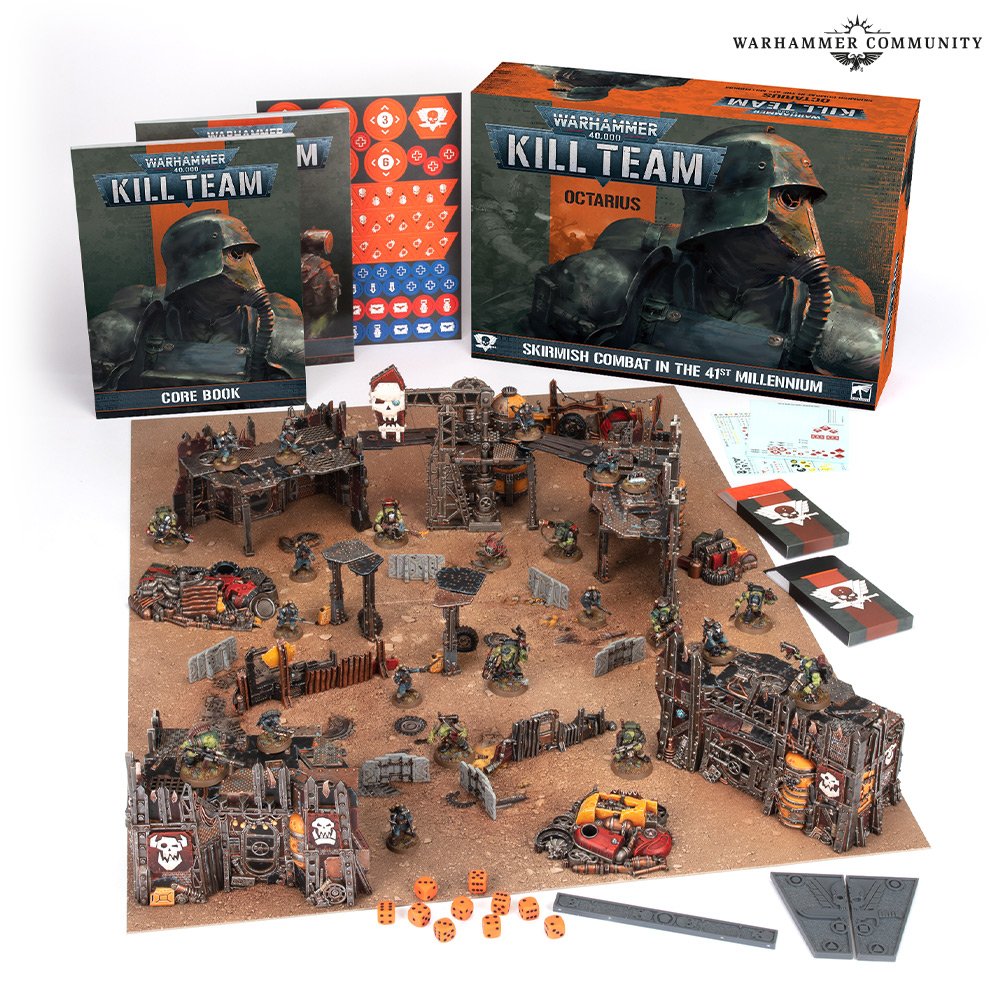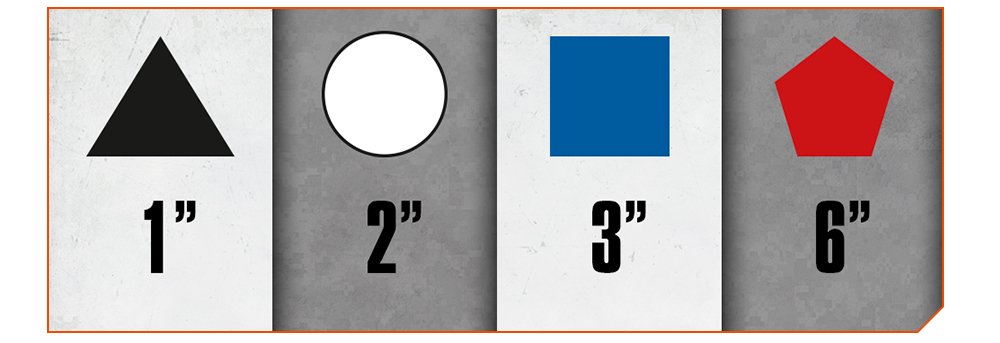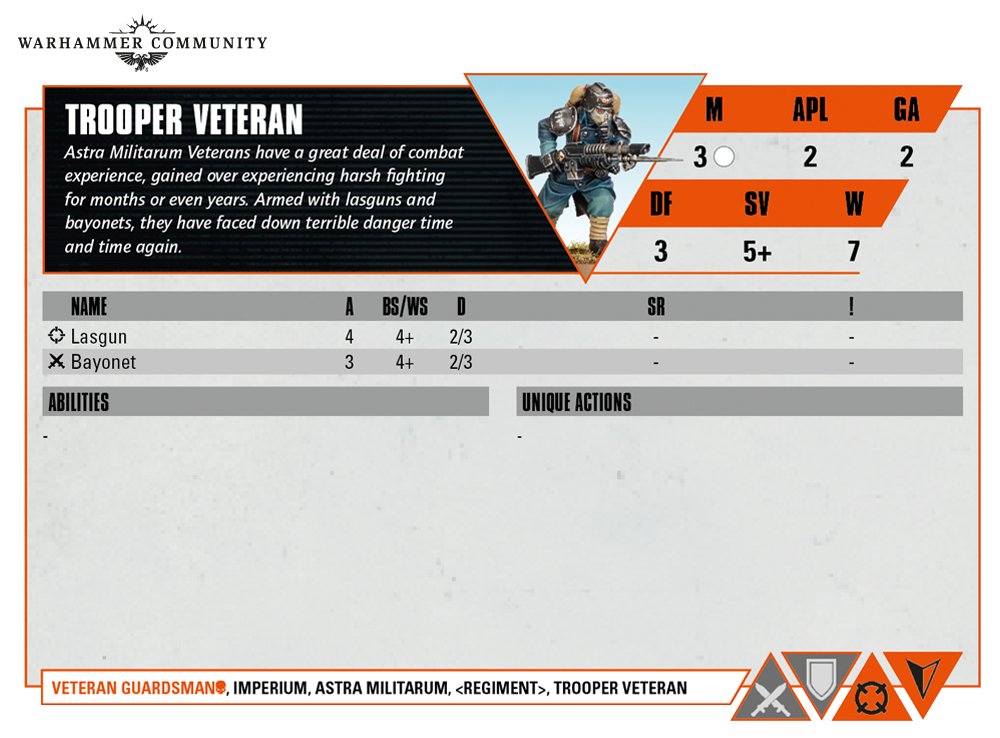The unending wars of the 41st Millennium are not only fought with titans, tanks and hordes of soldiers – sometimes victory is secured by small teams of specialist operatives fighting in the shadows. Warhammer 40,000: Kill Team allows you to play out these shadow wars.

In this article, I will explain what Kill Team is and how it plays, touch a little on why I think it’s great, and how you (yes, you!) can dive into the murky world of special operations in the 41st Millennium. All prices listed will be in British Pounds.
What is Kill Team?
Kill Team, unlike Warhammer 40,000, is a small-scale skirmish game. It’s more akin to Warcry, one of Games Workshop’s other skirmish games – it has alternating activations, uses a LOT of tokens, and is played with individual chumps (sorry, I mean operatives), rather than full squads. A game of Kill Team can take between 90 and 120 minutes and uses a small 22” x 30” board, which makes it ideal for pick-up games. You and your opponent assemble a team each from the models available within Kill Team for your preferred faction, give them a mission, and have a fight. A kill team can be anywhere from 4 to 12 models depending on your faction. Most, if not all of the teams available can be made with a single box of a basic Troops choice from your chosen 40k faction. While this may seem limiting from a personalisation perspective, the core fantasy of Kill Team allows you to really get creative – crack open your bitz box, grab your green stuff and go to town, because these aren’t just your regular, bog standard Intercessors/Guardsmen/Kabalite Warriors – These are your veteran, super badass, cool guy operatives.

How does it play?
Kill Team is a fast paced game – the alternating activations mean that there’s very little standing around waiting while your opponent does all of their stuff at once. Not only that, but Kill Team is a very lethal game – lots of weapons have a high damage output, and melee combat is particularly brutal. Even a guardsman carrying a humble lasgun and a bayonet can prove a serious threat if the rolls are on your side.
The available teams are split between the Kill Team Compendium, issues of White Dwarf magazine, and the Kill Team ‘campaign’ books (Octarius, Chalnath, Nachmund, and Moroch at the time of writing). The Compendium teams are variable in their competitive viability, if that’s your sort of thing – some are definitely stronger than others. The White Dwarf and ‘campaign’ book teams are generally more interesting, with themey special abilities and equipment.
Kill Team is slightly different from other Games Workshop games, in that rather than measuring in inches, you measure with shapes. “But JD!” You shout, baffled, “How can you measure in shapes?”. Well, the shapes correspond to a number of inches, but more importantly, the measuring gauges the game uses have the shapes sculpted on them.

This has been a somewhat divisive decision but, for my money, the shapes work really well – once you get used to them they feel very intuitive, especially when it comes to, for example, breaking up movement around corners or up walls. Every operative in your kill team has a profile card that shows you all of their relevant stats, weapon profiles and special abilities.

Let’s dig into what this beautiful nightmare of numbers and abbreviations mean. On the top right of the card, we see two lines of stats. From the top left to the bottom right, these are:
- Movement – Veteran Guardsmen have a move characteristic of three circles – a circle is two inches, so each guardsman can move six inches, which can be broken up into three two inch increments.
- Action Point Limit – This stat determines how many actions an operative can take during their activation. This guardsman has an APL of two, so they can, for example, move and shoot during their activation. APL is also used to determine control of objectives in most missions.
- Group Activation – This stat allows you to activate two or more operatives one after the other – This guardsman, being just a trooper with no special abilities or weapons, has a GA characteristic of two, which means that you can immediately activate another operative who also has a GA of two after this operative has finished their activation.
- Defence & Save – The defence stat indicates how many dice this operative rolls to defend themselves against shooting attacks. This guardsman has a Defence of three, so if they were targeted by a shooting attack, they would roll three dice, looking for the number of their Save (In this case, 5+) to defend against normal hits, or sixes to defend against critical hits.
- Wounds – The Wounds stat is one of the simplest – it just indicates how many points of damage an operative can take before they are incapacitated.
The weapon profiles are more straightforward – In front of each weapon’s name will be either a crosshair, denoting that it’s a ranged weapon, or a crossed swords symbol, indicating that it’s a melee weapon. Each weapon profile has an Attacks characteristic (A), a Ballistic Skill or Weapon Skill characteristic (BS/WS), a Damage value (D), and finally, Special Rules (SR) and critical hit rules (!). Let’s look at this guardsman’s lasgun as an example. It’s a ranged weapon that can make 4 shots which each hit on a 4+, and each successful hit deals 2 damage, or 3 damage on a critical hit. Because it’s a basic infantry weapon, it has no special rules and no extra effects on a critical hit. You may notice that unlike 40k, Necromunda and other Games Workshop games, most ranged weapons in Kill Team don’t have a Range characteristic. This is because it’s assumed that because the battlefield is so small, there’s no way that somebody would be out of range of, say, a boltgun or a shuriken cannon. The only weapons that tend to have a limited range are close range weapons like flamers, meltas and pistols.
This may seem like it would make shooting overpowered, but Kill Team has a pretty in depth cover system. Cover is super important in Kill Team – it can reduce incoming damage, and in some cases, make your operatives functionally invisible to ranged weapons. If you don’t take advantage of cover or line of sight blocking terrain, your specialist operatives will almost certainly be reduced to swiss cheese/molten slag/pink mist (delete as appropriate).
But How Do I Get Into Kill Team?
If all of this appeals to you (and it should, because it’s brilliant), then there’s a few ways to go about starting. I’m going to list the RRP of products, but they can generally be purchased for less than this from third party stockists.
- Pick up a Kill Team Starter Set: This is probably the easiest way of getting started with Kill Team, but it may not be the best – it will depend on how much terrain you already own, and whether you like the included Kill Teams or not. At £65, the starter box comes with the Core Book, 2 kill teams (Veteran Guardsmen/Death Korps of Krieg, and Ork Kommandos) and rules to use them, some basic terrain, measuring tools, barricades, and tokens. This is everything you need to play, but you won’t be engaging much with the terrain- and cover-heavy systems that make the ruleset truly shine.
- Pick up a big box/core set: These are larger boxes, with more terrain. The current core set is Kill Team: Into the Dark, which is £130 and comes with the core book, a campaign book, tokens, measuring gauges, 10 Imperial Navy Breachers and 10 Kroot Farstalkers, plus a whole bunch of awesome Zone Mortalis-style wall and floor tiles (fighting inside stuff, to the non-Games Workshop literate) to represent the interior of a drifting space hulk. Third party stockists may still have some of the previous core set available – Octarius (Death Korps of Krieg and Ork Kommandos). In between these two core boxes came Chalnath (T’au Pathfinders and Sisters of Battle Novitiates), Nachmund (Aeldari Corsairs and Chaos Astartes Legionaries), and Moroch (Phobos Space Marines and Blooded Traitor Guard). Any of these boxes are a great starting point, especially if you have a pal you can split them with. Just be wary – not all of them include the “getting started” bits such as the Core Book, tokens and measurers. Octarius and Into the Dark (and the Starter Set) do, the rest don’t.
- The Kill Teams and associated books from the previous starter boxes can also be bought separately, if only one of the teams tickles your fancy – the teams range from £32.50 to £40, and the books are £27.50 each.
- If you have a 40k army that you’d want to use models from, you can pick up the Kill Team Compendium for £32.50, or if your chosen faction has received a White Dwarf rules update, you can now pick up the Kill Team Annual 2022 for £27.50, which contains the rules for those teams, plus extra missions to play.
If you choose not to buy a starter box, it’s then worth picking up the Killzone Essentials box – this comes with the measuring gauges, tokens and barricade models for £22.50.
Kill Team is a fantastic game – one I could wax lyrical about for hours if given the chance. In my opinion, it’s one of the most intelligent rulesets GW has ever produced, with an extremely strong core fantasy. I hope to see you soon on the tiny battlefields of the 41st millennium’s shadow wars!



